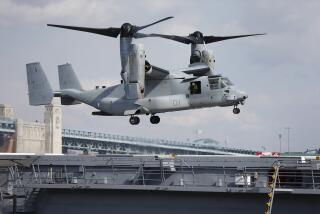B-2 Taking a Lot of Flak : Congress Urged to Stop Production After the 15 Already Authorized Are Completed
- Share via
For some months, the B-2 Stealth bomber has been losing its fight for survival because of rising costs and rising doubts that it could do any job better than far cheaper weapons. On Monday, Rep. Les Aspin, chairman of the House Armed Services Committee, fired a couple more rounds at its moving parts.
Aspin urged Congress to stop producing the hump-backed flying wings when the last of 15 already authorized is finished. Those 15 are enough to permit the Air Force to go on testing the plane’s new technology.
Aspin opposed a bill to shut the B-2 down last year, saying the Air Force was entitled to another budget cycle to make a better case for the plane. He now says it did not.
Aside from the absence of a clear-cut mission, one of the B-2’s most serious problems is rotten timing. A budget crisis, serious enough to force President Bush to suspend his no-new-taxes pledge, has Washington in virtual round-the-clock meetings seeking a way out. The last thing a government budget in that shape needs is the most expensive airplane project in aviation history, especially when the cost keeps going up.
For example, Defense Secretary Dick Cheney has ordered the Air Force to cut its planned B-2 fleet from 132 planes to 75. With production delays and inflation, the Congressional Budget Office calculates that the 75 planes will still cost nearly $7 billion more than what the entire fleet was estimated to cost in 1986.
To complicate the cost picture, the General Accounting Office, which keeps track of such details for Congress, warns that nobody will know for certain whether the B-2 can do what it was designed to do until another three years of testing is completed. This would make continued production fiscally dicey at any time; with the current budget crunch, it is even riskier.
Finally, with one exception, other planes or missiles can perform any mission the Air Force wants to assign to the B-2. The Air Force says it would need the B-2 to track down and destroy Soviet missiles that could be rushed into hiding in event of a nuclear exchange. The flaw in this argument, though, is that the first B-2s could not track down mobile missiles, either. Nor can anyone be certain that they could ever be equipped for such a mission.
Aspin’s attack did not appear to diminish White House enthusiasm for the B-2 Monday, and the Senate has not rushed to accept his position. But the stealth bomber cannot--and should not--shake off too many more direct hits like this.
More to Read
Inside the business of entertainment
The Wide Shot brings you news, analysis and insights on everything from streaming wars to production — and what it all means for the future.
You may occasionally receive promotional content from the Los Angeles Times.










